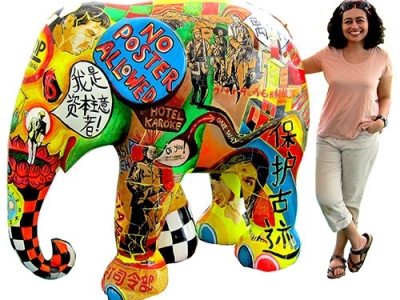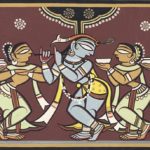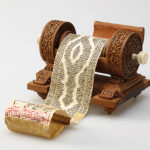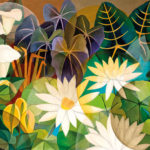Grand Narratives
Why did you leave Singapore?
For the last 20 years, I had become so comfortable with my habitat, dependable personal and working relationships, successful career, everything, that somewhere along the path, the edges became blurred, and life was being lived on autopilot mode. A Singaporean journalist had recently come to my door asking me whether I was a ‘bohemian’. Not knowing whether to laugh out aloud or invite the person in, the one truth that did dawn on me was this. Even though I have enjoyed the public validation of being appreciated as a relatively successful artist, I may have become a cliché! My external identity had become an impediment for my internal growth. It was time to move again, time to become ‘invisible’.
How did London help your art?
It brought changes in the manner in which I started participating with the external world. This city is the closest one can come to having one’s finger on the pulse of the world. My fascination with Britain has been renewed – its history, politics and its people. There are so many sub-cultures that exist within the larger framework of ‘British-ness’ – I’m not even sure what that term means anymore. Our diaries are full of protest marches, museum exhibitions, and lectures by outspoken individuals on topics ranging from genetically modified food to the excesses of capitalism. Compared to Singapore, we no longer have to ‘censor’ ourselves, and that in itself is so liberating. From Russell Brand to Vandana Shiva – there are compelling new thoughts out there, spoken without fear, frothing with self-awareness and layered intelligence. I thought there would be regret. But that didn’t happen – I moved away – and moved on. That only goes to show our minds and psyches are so adaptable. We fear change but when change is upon us we cope, and even grow in our new environments.
And then you migrated to Pune….
In many ways, life has come full circle, in that I am living in the same house in London where I grew up as a teenager. I ended by giving up Singapore and making the decision to explore both my identities – British and Indian. When the British winter starts setting in, along with my musician husband Jonathan Reading we pack our bags and fly to Pune, to live in a house we bought on the Internet 10 years ago. It’s a natural corollary as I am British-Indian. I have always thought that the clues to my ‘project’ in life lay in the cultural roots I was born with. Surely, there must be a reason why God made me an Indian. Indeed, why was I born in the same village in Gujarat as the legendary Sardar Patel? On my initial move to Pune, newfangled seeds were being planted, both in my garden and in the realm of relationships, all blessed by a fortuitous Indian monsoon – novel experiences, unusual insights, unique realisations.
How do you project your stories in your art?
It is this self-image, ethnic/national identity and the way we relate to each other that is under scrutiny in a lot of my work, which is ultimately about people. I try and chronicle their stories when they are the least self-conscious, and this I find in the street. This is where we reveal ourselves, where we collectively say more than we know. These information highways are full of information and clues as to where we came from and where we may be heading. I am not attempting to romanticise the past, but rather ‘re-validate’ it by showing the interconnectedness between our past, present and future.
Also, in an era of fast communication, market driven consumerism and celebrity culture, the ‘common man’ is becoming increasingly marginalised. His or her thoughts remain largely unexpressed, in lieu of rather inane sound bytes perpetuated by politicians or actors. Media-driven marketing has, to a great extent, replaced the ‘authentic’ voice. Using photographs I have taken of people and places visited and experienced, together with text from ‘found’ reading material, I collage and make up narratives that speak of a larger societal change. Taking a huge magnifying glass, I attempt to zoom in and ‘POP’ the story(ies) behind the ‘common man’, and Asian Street Culture, and in doing that, hopefully hold up a mirror back to ourselves.
Which is your favourite undertaking?
Last year I was commissioned by Tata Motors to convert one of their cars into a work of art.
The Nano, whether it has been successful or not, is an important symbol for India today. As the country gallops ahead into a denser, more global world, the ethos behind what the ‘Nano’ represents is quite phenomenal. More freedom, a dilution of hierarchies, consumerism, lifestyle, this small car is not just a nifty product from Tata Motors, but has become an emblem of a larger identity in a state of flux, and deserves much scrutiny. So I came up with a visual narrative that could be ‘wrapped’ up around the car, and we eventually manifested this using Italian mosaic from SICIS, the mosaic experts. The car had to be air freighted to Ravenna, Italy for this very special application. You should have seen the traffic it stopped when it was driven around Delhi!
Related posts from Verve:
Verve Trending
Sorry. No data so far.
us on Facebook to stay updated with the latest trends







